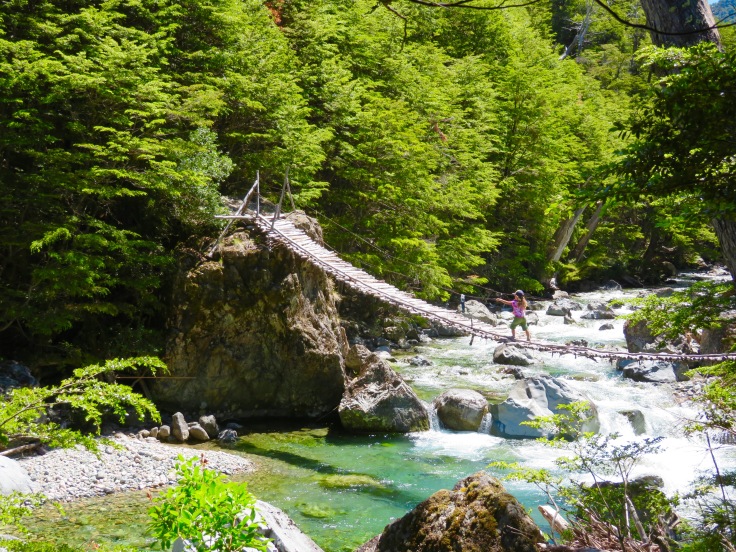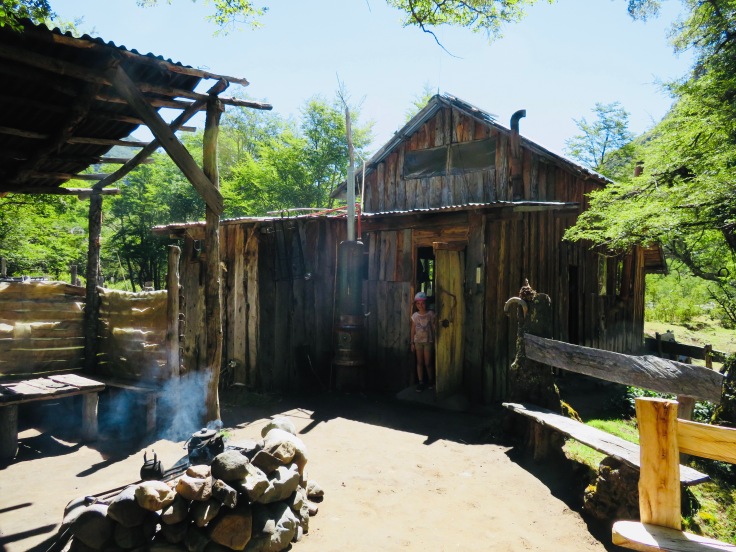Augustin’s bright smile greets us at the Encanto Blanco trailhead along with a small white and orange gatito. The cat immediately catches Mason and Celia’s attention. The boy is a teenager, but with a warmth and confidence that comes from knowing your place on the land and your roots so intimately. He talks us through important markers along the trail and shows us the sign with certain rules of the trail (no camping and no fires) and finishing conclusively that once we arrive to the Encanto Blanco Refugio we will be greeted “with a warm cup of yerba mate”. Claro que si.
Augustin is part of the Tilleria family, who manages the trail here and the Refugio above. He has grown up on his family’s estancia, amongst the blue rivers and condors of the Comarca Andina, a collection of villages and estancias surrounding the town of El Bolson in southern Argentina. This particular estancia commands a view of the Rio Blanco canyon to the west, where our route for the day directs us. The Rio Blanco is one of many rivers which drain from the Cordillera in this region, pouring from glaciers and forests and quenching the massive Lago Puelo to the South before filling the Puelo River and flowing to the Chilean coast. A 9 kilometer trek will take us to the Encanto Blanco Refugio – through forests of cipres, coihue, and lenga, most certainly bound along their trunks by the bamboo-like colihue, a most ferocious grass which creates the most ominous bushwacks and trail conditions in this part of the Patagonian mountains. Fortunately, these trails are well marked and colihue kept at bay by persistent machete – most of the trails through here are intended for horses. The Encanto Blanco is the northernmost of the refugios in the Comarca Andina, which number at least 10 and are connected by well-marked and mapped trails. They allow unusually (and relatively) comfortable and generous access to the Patagonian wilderness. Most sleep around 10-15 and are built of either stone or locally milled wood. They vary in their ruggedness, but most are simple mountain shelters, with only foam mats for sleeping and heated by wood-fired stoves and tended by cuidadores, many of whom spend the entire year in these high valleys. Well, “rugged” is also relative – they nearly all have artisan beer and fresh baked pizzas and bread.
We have opted for Encanto Blanco for its relative proximity to the trailhead as well as its relative obscurity, with the vast majority of trekkers heading up the Rio Azul Valley to the refugios around the famous Cajon del Azul. We figure that our family will do best with a shorter hike for our 4 and 6 year old as well as with a lower likelihood that we will be kept up at night by other visitors or them by us. A short taxi ride that morning had taken us through the pastoral Mallin Ahogado region, past yoga retreats and organic farms, and then on the road to the Perito Moreno ski resort, where the trailhead sits.
Augustin bids us farewell and, to Mason and Celia’s dismay, the gatito stays behind at the estancia as we head off on the trail. The trail passes the Tilleria family’s huerta, with papas, frambuesa, cebolla, lechuga, and sizable greenhouses for more warm-weather crops. The sheep and horses salute us as we head into the forest.
We realize quickly that family hiking (at least with Mason and Celia) boils down to a few important ingredients: time of day, food, grade of trail, and body temperature regulation. We miss the mark with the time of day and the food, having left town later than anticipated and having been caught in construction on the road paving project through Mallin Ahugado. After a few attempts to make due with snacks and games along the trail (seeing who could be first to spot the trail markers being one) in order to gain some ground, we decide to just stop and lunch on a fantastic spread of cured meat (err, salami), cheese (umm, swiss, kind of), mayonnaise and fresh baked bread. Keeping true to la vida patagonica with exceedingly simple foods. Celia and Mason truly were hangry – so, we commit ourselves to always remembering rule number one of family hiking: when it’s lunch time with a child, eat lunch. Freshly fueled, Mason and Celia keep a steady pace through increasingly primary forests as the trail climbs to a shelf along the Cerro Perito Moreno and then drops into the crystal waters of the Rio Blanco. Mason takes up trail running (for the exercise, we can only suppose) as we wind through switchbacks to the river.
The austral sun, just past its yearly zenith, blazes down on our boreal shoulders and cheeks as we come alive into a new kind of January summer. It is early afternoon and the Rio Blanco provides an immaculate shelf to dip our toes and then our bodies into her water for a mid-hike refresh. From here the trail crosses a (hilarious or precarious?) hanging bridge to the southern flank of the river and then continues for another 3 kilometers to the Refugio.
We really are proud of Mason and Celia as we open the gate to the refugio. They gracefully completed their first Patagonian hike and did so having enjoyed it. We are greeted by our hosts Bruno and Tito, but, conspicuously, sans yerba mate. I don’t mention it, but am surprised. Bruno is an impressive recluse, sometimes spending the entire year at the refugio or, as he states it he “stays in the winter until the trail clears of snow to be able to go back down again”.
Photos on the walls of the refugio show the lenga or beech forests ablaze in autumnal reds and then others with mounds of snow covering the bridges and trails. Sketches of trekkers. Thought provoking quotes such as “if you don’t have a plan for where you’re going then you’re never lost.” A copy of 1984 in English. Playing cards. “Gracias Bruno y Tito” cards.
Here they tend chickens, horses, and cows, brew beer and bake bread. The shelter is creatively patched together, with cardboard holding in plastic vapor barriers and insulation in the roof and a bit of cardboard weather-stripping literally stapled to the edge of the door to seal it in the door jam. The Refugio Encanto Blanco was built in 1999 by Tito’s father (Don Tilleria, we suppose), and has required some maintenance. Industrious solutions to some Patagonian problems that result from rain, wind, and cold. Cooking is over a wood-fired stove, which also churns up impressive heat. All pots and pans have thick carbon layers coating them. Cold water does little to scrub the char.
Two nights and one day at the refugio give ample time to explore the nearby waterfall and look-out, play futbol in the small field, build cairns. Children create numerous myths and legends by the river with the sand, stone, and driftwood. They gather cow bones into a shrine. I plot a route up the Dedo Gordo peak to the south, through crumbling rocks and thickets of roses (rosa mosqueta) and other harsh vegetation – it is most definitely a terrible route. I explore a valley further up-river on a trail run, always looking upward towards the rocks. The kids hone their skills at Go Fish and War, and they both begin to get a taste for yerba mate. Mason is uniquely drawn to the yerba’s bitterness. We celebrate with alfajores. We eat simple food. We embrace the wind and the occasional mists that resemble rain. The cirrus clouds rip through the atmosphere at speeds that can only exist at this southern edge of the world. Rain is forecast for our hike out on the third day and the cirrus clouds are harbingers of this change in weather. Two condors circle the high crags of Cerro Perito Moreno to the north. This feels so unbelievably vibrant and complete to be here as a family.
The hike out goes swiftly and we learn from our hike in. We start early after a large breakfast and eat lunch before we get hangry. We feel light as we pass the hanging bridge and in to the descent back to the valley. As we near the Tilleria Estancia, Augustin and a companion pass us on horseback. The two horses are saddled for cargo and a chainsaw sways along the side of one of the horses. Two dogs provide company – one conspicuously on a leash. Or, rather, a chain. We climb the final stretch to the house on the road with the view of the range and hear the firing of the chainsaw in the distance. A firewood run, we assume. Gatito bounds to greet us and we share the remainder of our food, including our final two alfajores.
– Tim






January 15, 2019 at 8:46 pm
Oh my gosh- I love this!! What a beautiful journey. Thank you for sharing it… I am absolutely there in spirit and desperately wish we were there in flesh. Love love love you all. Xoxo miki
LikeLike
January 16, 2019 at 8:18 pm
Wow! This is incredible, I loved reading about this experience you all shared and seeing some photos. How magical! Keep the posts coming! Miss you guys. Abrazos
LikeLike
January 19, 2019 at 12:55 pm
Loved reading this and seeing these great photos!! What an amazing experience for Celia and Mason and for you as a family. Love you all! Michelle
LikeLike
January 19, 2019 at 7:50 pm
Sounds divine!! Enjoy every minute, much love to the fam!
LikeLike